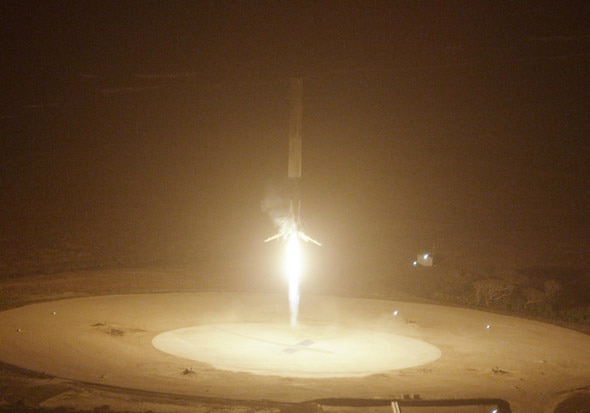Create a free profile to get unlimited access to exclusive videos, sweepstakes, and more!
SpaceX Releases New Photos of the Booster Landing

On Tuesday, the private rocket company SpaceX performed an extraordinary feat: returning the first stage booster of an orbital rocket back to ground, landing vertically on its tail, right in the center of the landing pad.
The video is incredible, and now SpaceX has released lovely high-res photos of the event as well. I want you to see these pictures here because a) they’re very cool, and 2) there’s a point I want to make at the end. Also, click on the pictures to make them full size; I had to crop them a bit to fit here. They’re worth it.
Moments before landing, the booster comes in at a slight angle from vertical. Onboard software senses the orientation of the booster (as well as wind speed and other factors) and corrects for it to ensure it lands vertically. Note the landing legs, deployed earlier, after the booster separated from the rest of the rocket, sticking out the bottom at an angle.
A second or two later the booster has reoriented itself, and is very near vertical, ready to land. The rocket exhaust is hitting the ground and billowing out.
From a remotely controlled drone, the view is even more dramatic. As you can see, the booster is almost exactly centered over the stylized X (the SpaceX logo, but also a convenient way to mark a spot, say).
Speaking of which, here is Landing Zone 1 before the booster landed. Note the person standing in the middle, arms wide (hopefully more as a “Look at this!” expression more than “I got it! I got it!”). This should give you a sense of scale …
Now look at the booster sitting on the pad. The whole time it was landing, and even looking at these photos, I had a hard time grasping the scale of what I was seeing, even though not long ago I stood right next to one of the landing legs and saw the size of the boosters when I visited the SpaceX factory earlier this year.
Note the person in an orange jacket crouched over by the landing leg on the left. The booster is far bigger than you think! It stands more than 40 meters in height, as tall as a 12-story building, and even empty weighs something like 20 tons.
Got that? So this is what SpaceX did: They took a 12-story rocket weighing 20,000 kilograms moving at 6000 kph, slowed it, stopped it, turned it around, let it fall nearly 200 km to the ground, reignited the engines, had it follow a descent path, automatically correcting its orientation and attitude, until it landed within a few meters of the pre-chosen spot.
That is (in part) why I was excited about this feat: It was an astonishingly complex technological process, and they nailed it. And now the booster will be checked out to see how it fared during all this. It may get cleaned up to be reused, though in a press conference after the launch Elon Musk noted they may keep this one as a memento to the achievement*.
So as I pointed out in my original article, the story is not yet done. This was the first step: getting the booster back on the ground. The next step, the critical one, is to reuse the booster (or whichever one is brought back down to the ground next). Once that has been achieved, then Musk and SpaceX will have shown they can reuse that rocket, and potentially save tens of millions of dollars on a launch into orbit.
Musk estimates the cost to build a first stage Falcon 9 at about $60 million while the fuel costs around $200,000. If they can reuse that booster, then even if it costs a few million bucks to fix it back up, that’s a savings of more than $50 million in launch costs … on a launch that costs roughly $90 million to start with.
If this works, then launch costs can be cut in half. And that is the second part of why I was so excited about this landing. I hope this all works. Between this effort, Blue Origin’s recent flight into space and back, NASA’s Orion capsule, Boeing’s CST-100 capsule, Sierra Nevada’s Dream Chaser, and Virgin Galactic (despite the awful loss of its SpaceShipTwo in 2014), we are in an unprecedented moment: More human-rated spaceships are in development now than in any time since the Space Age began.
Where will we be in 20 years? I can’t say for sure, but if everything goes well, more humans will be in space than in all of history. That is a future I very much look forward to.
* Correction, Dec. 28, 2015, at 16:50 UTC: I originally wrote that the booster would be kept at the SpaceX factory, but its actual final destination hasn't been determined.


























